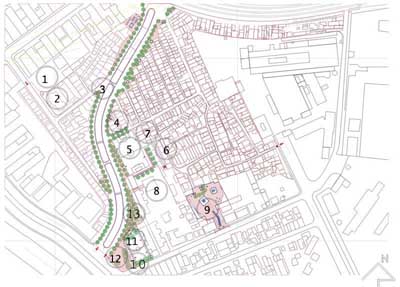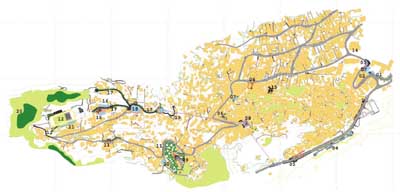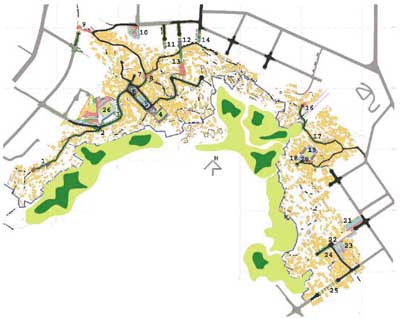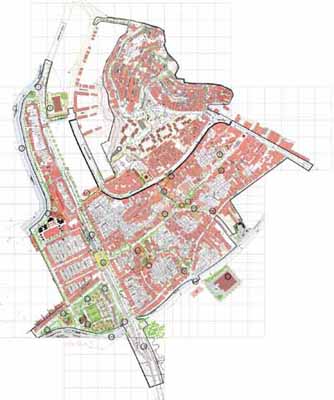| Favelas |
| Urban Upgrading: Urbanistic, social and economic Articulations |
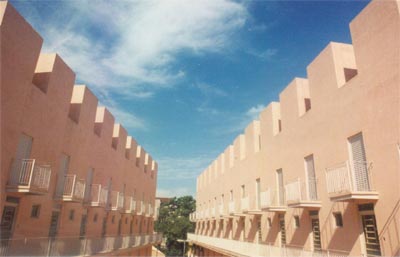
Relocation building
of Favela dos Macacos
Brief
Description:
These are two cases, in different topographic and urban insertion conditions,
included in the Favela-Bairro programe, located in Rio de Janeiro. Based
on the reading of the structure of the place, the specific urban scheme
is elaborated listening to the local organized communities, and interpreting
the demands in an amalgam of physical, social and ecological dimensions.
These projects are the "favelas" of Fernão Cardim and Fubá-Campinho.
What
do you think were the highlights of this project?
The central issue is the "city construction", searched through the configuration
of spaces for community conviviality (squares, center for generating of
work and income, cultural and sports facilities, daycare, health posts,
community open spaces, etc.) and the net of infrastructure, with new ways
and the reconfiguration of the existenting ones. The articulation between
physical (urbanistic, infrastructural and environmental) and social (cultural,
economic, and existential) aspects is founded on mental, social and environmental
ecological approach. This is the way in which a multidisciplinary procedure
takes place and maintains the dialogue with the local community throughout
the process.
Objectives
of the Project:
The main objective is to promote social evolution, having the urbanistic
intervention as an activator. The principal purpose is to take the city
to the slum, introducing urbanistic attributes (services, infrastructure,
community spaces and "prestigious equipments") into the "favela".
Components:
The project of urbanization is executed by a multidisciplinary team, coordinated
by an urbanist-architect. It includes different engineering skills (soils,
buildings, contentions, infrastructure, etc.), a sociologist, an urban
geographer, a psycho analist (to help us to listen the demands), among
others.
Lessons
What
worked and why?
The relation between the architects and the community. That is, the dialogue
that permits to emerge objective and subjectives questions, and to translate
them into spatial and formal configurations, with high quality, generating
adhesion to the program, and making people feel they belong.
What
didn't work and why:
The projects and the execution work better depending on the level of organization
of the community. When the community is more organized and independent
from the drug dealers, things flow better.
Tips
for other practitioners:
The most important tip is to attempt to promote the necessary interconnection
between erudite culture (academic, disciplinary) and popular culture (based
on the proper experience of doing) without "mimetisms", with severity
and consistence, listening to the people and reading the structural conditions
of each place that must be interpreted in the urban scheme.
Evaluations:
The town hall, different universities and other institutions, make the
evaluations.
Scales
of Intervention: S, M, L, XL
Different scales of intervention imply different possibilities and different
demands, too.
a) A small scale (S) has a more internal character in relation to the
community; an influence only over a proper area of action (500 families).
b) A medium scale (M) has a range of influence that includes the immediate
neighborhood (from 500 to 2500 families).
c) A large scale (L) covers the immediate neighborhood and can be projected
on a greater zone (over 2500 families).
d) An extra large (XL) scale has an influence area that encompasses the
surrounding districts, and even an ample sector of the city, with consequences
over the whole of the metropolitan structure (from 100.000 to 300.000
people).
The
response to the demands
This is a very important question in relation to the individual as well
as the collective demands.
According to psychoanalysis, the question is not to respond but to interpret
them in a consistent configuration that requires the articulation of ethics,
esthetics and politics.
Psychoanalysis draws our attention about the question relating with the
ethics when, facing all types of determinations (economic, social, cultural)
the "projectual act" must impose an ethical position that could be summarize
as the following: "it is necessary to do what is necessary doing". But
this duty is not in relation with morals or law. It is a duty in which"
beyond the demand" is put permanently in question.
It is for this reason that the question is not to try to please, like
a manner of seduction or harmony; however, this is not the fundamental
issue.
We can say that the ethic of an architect is related with the intangible
that sees-through the articulations that are made between the project
("dessin") and the intentions ("dessein") which it points to.
So, it is necessary to know that the question of the "interpretation"
of the demands implies "listening" beyond the declarations, differentiating
between latent and manifest demands. This signifies making the difference
between doing what the client asks, and doing what he desires, what he
needs, which almost never coincides with what he asks for.
If we act according to the clients request, we don't get to understand
him, but only to obey him responding to his manifest demands but not to
the latent demands.
The question is not that "the client doesn't know what he wants", but
to listen, to understand, to establish a hierarchies and to organize the
whole of dreams, problems, limitations, potentialities and expectations
put around the demand, overtly or covertly.
For these reasons, "listening to the demands" is not "responding" but
going further, searching for an intersection between the physical, the
social and the ecological, that must be articulated in the project.
The physical means the urbanistic, infrastructural and environmental aspects;
The social is considered as the economic, the cultural and the existential;
The ecological comprises three ecologies: mental, social and environmental.
Mental ecology involves the depollution of the pre-conceptions in order
to face them and to think about all their corresponding questions.
Social ecology comprises the revision and reformulation of the whole of
social relations; the "socius".
Environmental ecology including the form of the sustainable development,
that implies the revision of all types of relation with nature.
Other
Comments:
The most important question in relation with the formulation of an urban
upgrading project, is to know how to have the reading of the structure
of a place. this reading implies to identify, to organize and to translate
into a consistent formalization all the factors that intervene in the
constituition of the problems.
FERNÃO CARDIM
This
urban renewal plan is structured around a 1.5 - kilometer axis, configured
by the channelization of the Faria River , the revitalized areas bordering
on the river, and the buildings and other facilities called for by the
project.
The area along such river resulted in what city planners call a "no-place".
The goal of this project was to bring the city to the favela, integrating
it with the district through the construction of a linear centrality resulting
in a "urban façade".
The area's image was reconfigured by a public "Favela-Bairro" integration
square linking the favela with the adjacent district. Kiosks for generation
of job and income, sports areas, vegetation for a creation of a shaded
area, riverbank treatment, and significant urbanistic/architectural "events",
result in a urban continuum that does away with the "divided city".
Fernão Cardim is one of the first examples of the urbanistic and social
integration of a favela, that has blurred the borders between the formal
and the informal, between favela and district, to the point that it is
impossible to tell them apart, besides giving the inhabitants a new sense
of belonging.
VIDIGAL
The
Vidigal favela is structured around a curving, linear core.Taking full
advantage of the local landscaping potential, a series of functional elements
was configured for installation along a one-kilometer stretch, constituting
community foci of varying strength and character. It begins at the entrance
of the Favela-Bairro articulation square adjoining Avenida Niemeyer and
ends at the upper outlook at the top of the proposed passenger cable-lift
system. Complete the intervention a sports complex, a covered gymnasium,
a community square, and an ecological preserved area, as well as a daycare
center and job-training center, a community and social development orientation
office, and community laundry, each constituting a microcentrality connected
to the axis defined by the project.
Because of its history and location-it is embedded within one of the highest
property value regions in Rio's South Zone -in just a few years this favela
will, through community development actions according with the Town Hall,
become an urban landmark and be transformed into a new particular district
of the city.
FUBÁ - CAMPINHO
This complex of four
favelas presents two clearly defined urban renewal intervention nuclei,
connected by a pedestrian footway.
The project first started recognizing the centralizing forces exerted
by both the Campinho Residents Association's of the existing "Escola de
Samba" and Fubá's soccer field, and sought to strengthen and further empower
them.
In Campinho the project configured the public space through the creation
of accessways leading to the top of the hill, including public squares,
areas for sport and leisure, the establishment of a daycare center, resettlement
units, a local station for the trash collecting company's building, and
the headquarters of the community renewal and social orientation office,
thus reinforcing the attractiveness of the locale. The development work
included general reforesting of the area, installation of public furnishings,
placement of signage, and a public lighting system. Streets supporting
vehicular as well as pedestrian accessways converge on this center. In
this configuration, the center has the characteristics of the central
square of a countryside town, concentrating around it all the main civic
functions necessary to the day-to-day life of the residents and the associative
life of the community.
In Fubá, the soccer field was reshaped and the streets supporting vehicular
traffic were built leading up to it, halfway up the hill. Around the field,
bleachers and leisure areas were built, as well as a community center
that includes a post office, bathrooms and dressing rooms, an events hall,
and a new station for the Residents Association.
The link between the favelas was assured by significant construction work
on the pedestrian footway located along the only stretch that the very
rugged terrain permitted.
RIO DAS PEDRAS
The
Rio das Pedras favela project is one of Rio's largest, with a population
of 60,000 inhabitants (12,000 families). Besides the typical problems
of favelas, it presents other extremely serious ecologic/environmental
issues due to the presence of dwellings on the edge of the Camorim Lagoon.Because
all the dwellings in risk areas needed to be removed, this case required
the construction of a significant residencial sector that became one of
the area's new centers.
The urban renewal plan defined the overall structure of the area and each
of its sectors, configuring the centers in a way that the preexisting
functions would articulate with the new constructions, spaces and services
brought by the project. A new system of pedestrian an vehicular traffic
was structured for circulation withing the favela, and for linking it
with the surrounding districts, thus allowing for new accesses and new
relations among the various sectors.
A new "urban façade construction" defines the borthers of the favela,
limiting the area of occupation and preventing its expansion. A sports
area, an ecological park, a center for generating jobs and income, plus
a new public square all function together to link the favela with its
surroundings. Within the favela the urban renewal work was completed by
the creation of public squares, the treatment of residual areas, the opening
of "clearings", new street connections, the planting of trees throughout
the favela and a system of signs and new public lighting.
